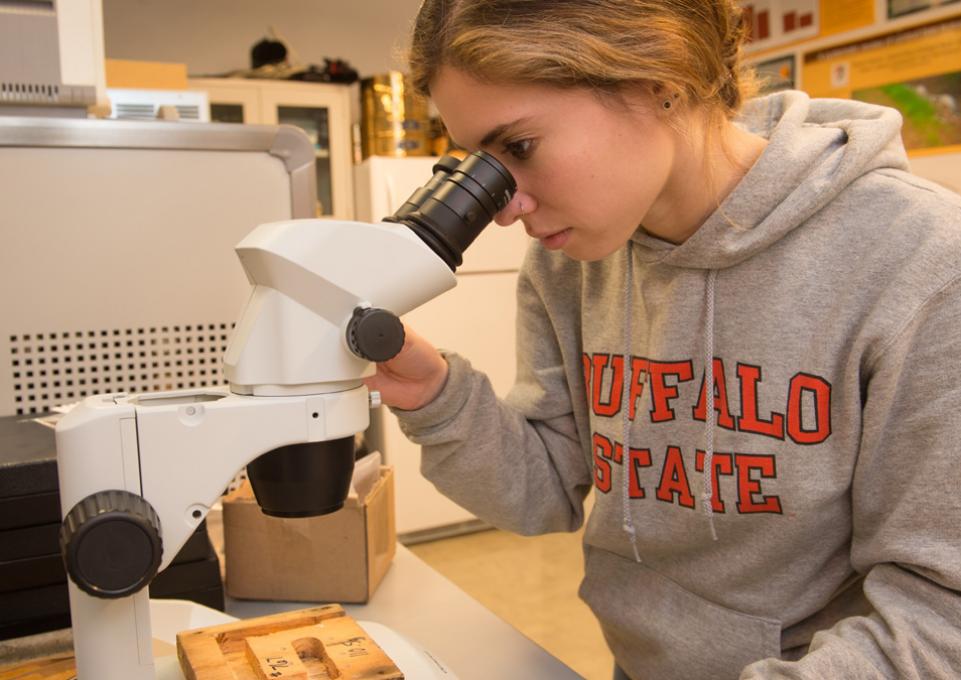
Robert Warren, associate professor of biology, was devoting 40 to 50 hours a week building wooden nests in his home workshop to study ant behavior, termites, and climate change.
Through a partnership with the Engineering Technology Department (ETD), however, the nests are now created in a matter of hours through the use of a computer numerical control (CNC) router, which creates the notches in the wood used for the nests automatically.
That frees up Warren and his student helpers to conduct more research.
“We’d be lost without their help,” he said, referring to ETD. “This research just takes so much time to do.”
The partnership stems from a conversation Warren had with James M. Shea, associate professor of engineering technology, while socializing at Campus House, a social club for the Buffalo State community. Warren explained what he needed, and Shea said his department could make the nests in no time with the machinery available, including the CNC router and several three-dimensional printers.
James Kolarich, an instructional support technician in ETD who runs the machines, said they’ll help out with special requests, especially when they have to do with research. The machines are in constant use by students.
“Our first obligation is to make sure our students have access to get their class projects done for grading,” he said, adding that they operate a laser engraver, a CNC router, and three 3-D printers that can be used by faculty members for special projects.
The nests, which hold between 300 and 400 ants each, are valuable to Warren for several reasons. First, they allow him to study the ants in a controlled environment, and watch how they maintain their living space. Second, the nests allow him to observe interactions between ants, termites, and fungi. As climate change makes the area warmer, those interactions will no longer be relegated to the South, he said. Warren currently has 100 unused nests in his lab, and 24 that are being used in a forest warming experiment in Athens, Georgia.
He and his team also discovered that the ants were inadvertently protecting wasp eggs by bringing them into the nest. While the ants collect and disperse seeds, they also bring leaf galls back to the nest. Leaf galls are abnormal outgrowths of plant tissue that develop in response to a disturbance, such as a wasp depositing its eggs on the surface, Warren said.
“There’s a chemical that prompts the leaf to grow around the eggs, and that protects them,” he said.
For at least one species of leaf, the gall will drop off. When that happens, the ants pick it up and bring it back to the nest, possibly thinking it’s a seed.
“If you’re a baby wasp, you’re essentially in a perfect place,” he said. “You’re protected by all these ants. The wasps are taking advantage of ants. We would have never discovered that without these nests, because if you go digging up nests, everything’s a mess.”
Warren isn’t the only Buffalo State faculty member who has capitalized on such cross-campus collaboration. Gavin Leighton, assistant professor of biology, has also worked with ETD. For Leighton, the need was decoy woodpeckers for a multi-year research project.
Leighton is examining why the downy and hairy woodpeckers look alike. For a long time, researchers thought the birds were similar in makeup; but despite having nearly identical plumage, the birds, it turns out, are not closely related after all.
“I’m trying to figure out why one of them has evolved to look like the other,” he said, noting that it’s somewhat difficult to work with live birds.
To that end, Leighton has enlisted the help of the 3-D printer to make the decoys. It’s saved him money as well as made the whole process much easier.
“I was happy that someone on campus could do this,” he said. “Jim and Engineering Technology were very easy to work with. They have a great setup over there.”
The printed decoys are painted to look like downy woodpeckers, which look like the hairy woodpeckers only smaller. The decoys have been placed on bird feeders in West Seneca, New York, where a student spends several hours a week observing how other birds interact with the decoy. The theory, Leighton said, is that the downy may have adopted the plumage of the hairy to appear like the larger, tougher woodpecker. The research will be presented during the spring 2020 Student Research and Creativity Conference.
Some other examples of cross-campus faculty collaboration will be on display during the 20th annual Faculty and Staff Research and Creativity Fall Forum on Thursday, November 14, from 11:00 a.m. to 1:30 p.m. in Houston Gym. The forum aims to foster and support collaborative research endeavors among faculty and staff members. It’s also a chance for faculty and staff to network and discuss common scholarly goals, creative interests, and funding opportunities.
Pictured: Undergraduate student research assistant Megan Calcaterra working in Dr. Robert Warren's lab at Buffalo State College.
Photos by Bruce Fox, campus photographer.
